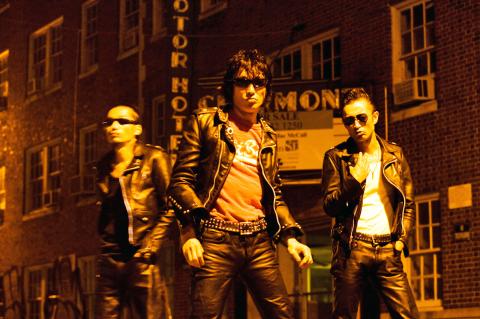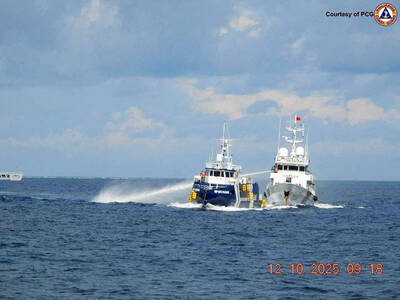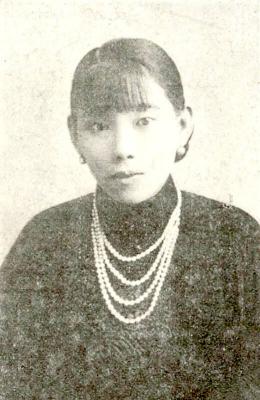Watch out this weekend ’cause a big, bad wolf will be rocking at the door. For the past 20 years, punk rockabilly legend Guitar Wolf — a Japanese three-piece outfit composed of Guitar Wolf, Bass Wolf, and Drum Wolf — have blasted eardrums and broken sound barriers. The group has toured with the Cramps and played with the Jon Spencer Blues Explosion, and made audiences howl at events like Fuji Rock, Rock in Japan and SXSW.
After a tour of Japan in September, the US last month, and a recent Matador Records showcase with Pavement and Sonic Youth, the band is playing in Kaohsiung tonight and Taipei tomorrow.
Matador Records said that when the band sent in the master for its album Jet Generation, the sound engineer said the sound “levels exceeded the theoretical maximum possible on compact disk,” and that it was “the loudest CD in history.”

Photo courtesy of Guitar Wolf
Guitar Wolf’s sound is heavily influenced by the Ramones, with elements of the Boredoms’ future-wave noise punk and what the band calls “Jet Rock,” a tip of the hat to Joan Jett, a long-term inspiration and hero for Seiji (aka Guitar Wolf). He was 18 years old when he first saw her play and was taken “prisoner” by her “leopard eyes,” he said in a recent e-mail interview.
The group’s most popular albums are Planet of the Wolves and Jet Generation. The most soulful is Dead Rock, composed after the original Bass Wolf, Billy, died of a heart attack in 2005 aged 38. The tragedy tempered the band members’ hard-drinking lifestyle, though they still keep a beer machine in their office.
The band’s look and attitude are as important to Guitar Wolf as the music. Seiji’s fashion revolves around a black-on-black theme — omnipresent wraparound shades (one interviewer commented that in 13 years of knowing Seiji he’d only seen his eyes once) and a collection of leather jackets that include one signed by the Ramones, one signed by Joan Jett, and a black-and-white jacket similar to the one Johnny Thunders wore.
Interviewing such a band presents it’s own difficulties.
Asked how he decided to make rock ’n’ roll his life, Seiji wrote: “Human is not to become a person who can become it. It becomes the one wanting to become it.”
Seiji went on to explain that rock ’n’ roll was the best way for him to “keep cool” and to be “popular among lovely girls.”
But what can fans expect from the show?
“If you are bitten by us, you are [in] serious [trouble],” Seiji wrote. “You might [catch] the sickness of intense rock and roll. Give an antirabies serum for the case.”
“Our new album is coming soon,” Seiji wrote. “Anyway, we can’t wait to eat you.”

Many people noticed the flood of pro-China propaganda across a number of venues in recent weeks that looks like a coordinated assault on US Taiwan policy. It does look like an effort intended to influence the US before the meeting between US President Donald Trump and Chinese dictator Xi Jinping (習近平) over the weekend. Jennifer Kavanagh’s piece in the New York Times in September appears to be the opening strike of the current campaign. She followed up last week in the Lowy Interpreter, blaming the US for causing the PRC to escalate in the Philippines and Taiwan, saying that as

US President Donald Trump may have hoped for an impromptu talk with his old friend Kim Jong-un during a recent trip to Asia, but analysts say the increasingly emboldened North Korean despot had few good reasons to join the photo-op. Trump sent repeated overtures to Kim during his barnstorming tour of Asia, saying he was “100 percent” open to a meeting and even bucking decades of US policy by conceding that North Korea was “sort of a nuclear power.” But Pyongyang kept mum on the invitation, instead firing off missiles and sending its foreign minister to Russia and Belarus, with whom it

The Chinese Communist Party (CCP) has a dystopian, radical and dangerous conception of itself. Few are aware of this very fundamental difference between how they view power and how the rest of the world does. Even those of us who have lived in China sometimes fall back into the trap of viewing it through the lens of the power relationships common throughout the rest of the world, instead of understanding the CCP as it conceives of itself. Broadly speaking, the concepts of the people, race, culture, civilization, nation, government and religion are separate, though often overlapping and intertwined. A government

Nov. 3 to Nov. 9 In 1925, 18-year-old Huang Chin-chuan (黃金川) penned the following words: “When will the day of women’s equal rights arrive, so that my talents won’t drift away in the eastern stream?” These were the closing lines to her poem “Female Student” (女學生), which expressed her unwillingness to be confined to traditional female roles and her desire to study and explore the world. Born to a wealthy family on Nov. 5, 1907, Huang was able to study in Japan — a rare privilege for women in her time — and even made a name for herself in the